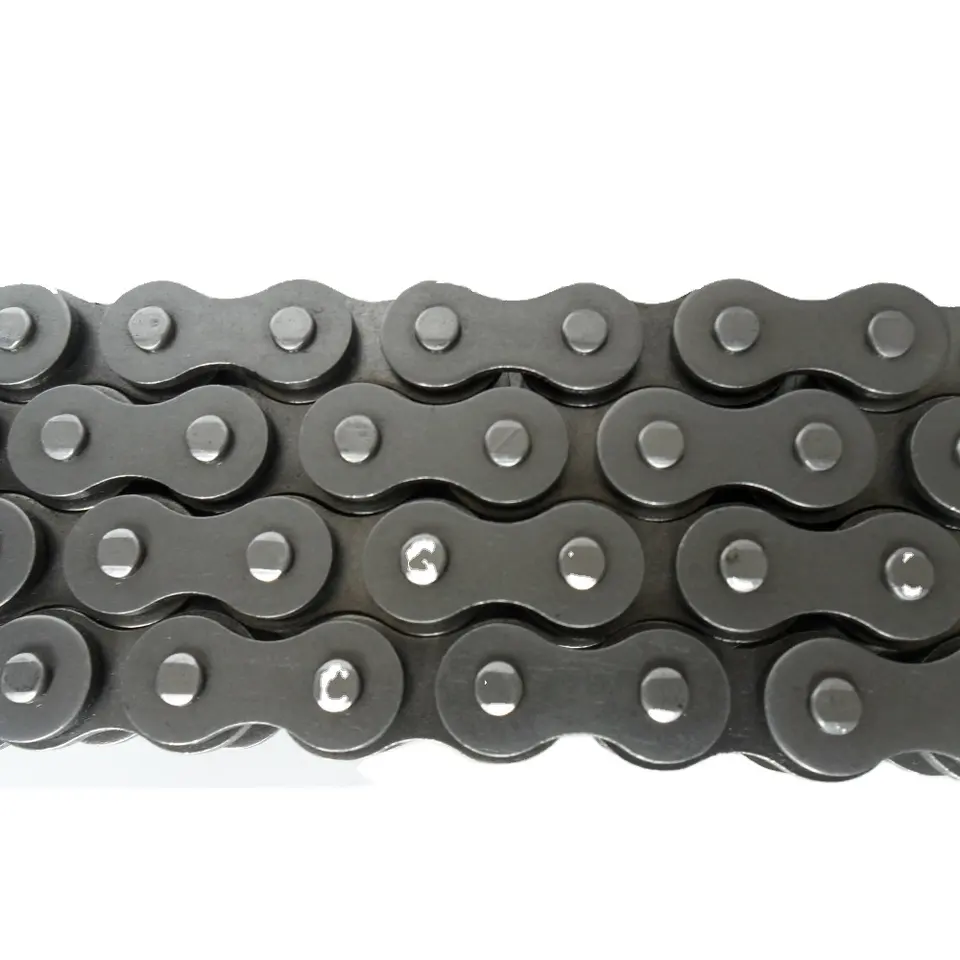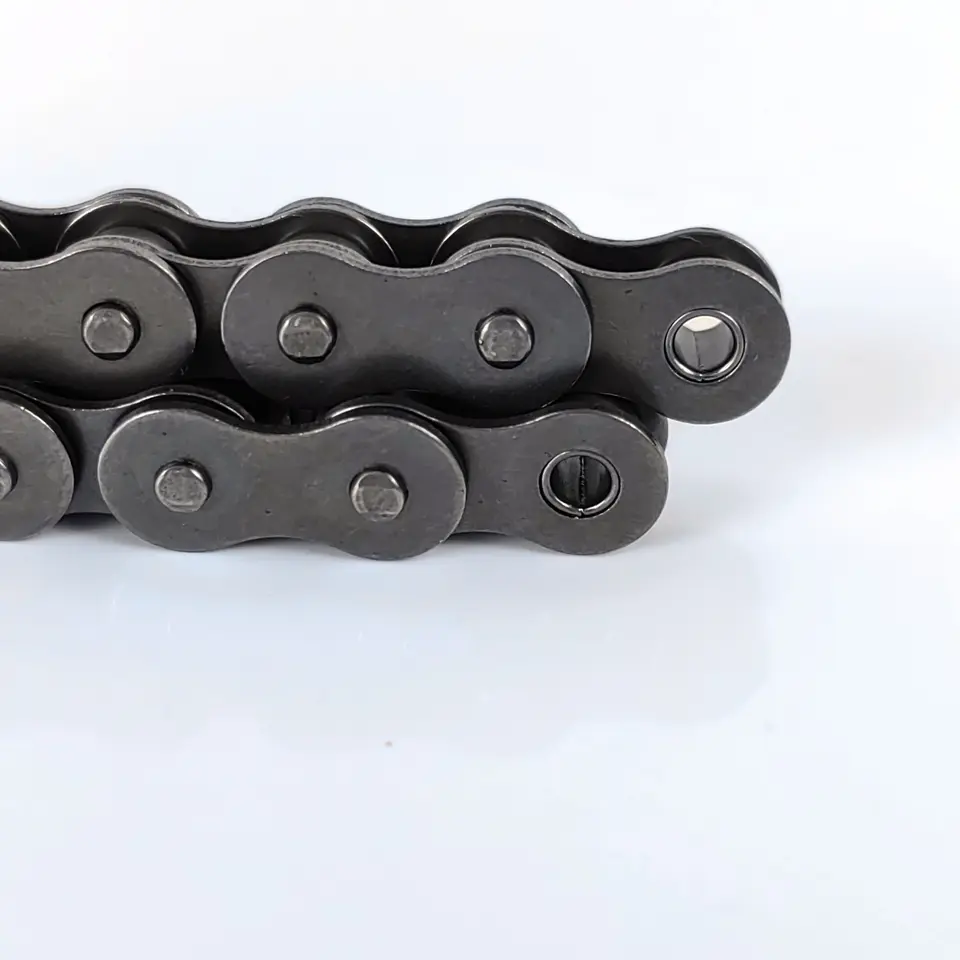Product Description
Product Description
A sprocket is a wheel with cogged chain teeth, which is used to mesh with the accurate pitch blocks on the link or cable. It is widely used in the chemical industry, textile machinery, escalator, wood processing, three-dimensional parking garage, agricultural machinery, food processing, instrumentation, petroleum, and other industries. Sprockets usually include many models, and different models are described in different ways.
As 1 of the leading China sprockets manufacturers and suppliers in China, we ensure the high quality of every sprocket. Trust us and contact now for more information!
Product Parameters
Company Profile
Services we can provide
1. Produce strictly following standard dimension
2. Material: 1045 Steel / Alloy Steel / Stainless Steel 304 & 316
3. Standard: ANSI, DIN, JINS, ISO, KANA, Standard America, or customer’s drawing
4. Pilot bore, finished bore, taper bore, and special bore.
5. Bright surface / high precision / Blacking /Electrophoretic-Coated
6. Advanced heat treatment and surface treatment craft
7. Best quality and competitive price.
8. Welcome OEM / ODM
9. Processing Equipment: Hobbing machine, Slotting machine, CNC lathes, and other equipment.
10. Sprocket Models: Contains special sprocket according to customer’s drawings, standard sprocket (American standard and metric).
Customization process
1.Provide documentation:CAD, DWG, DXF, PDF,3D model ,STEP, IGS, PRT
2.Quote:We will give you the best price within 24 hours
3.Place an order:Confirm the cooperation details and CHINAMFG the contract, and provide the labeling service
4.Processing and customization:Short delivery time
Related products:
Factory:
As a professional China sprocket manufacturer and professional supplier, we ensure the quality of every sprocket. All items are checked and tested thoroughly during every working procedure and after the product is finally manufactured to ensure that the best quality product goes out in the market.
/* January 22, 2571 19:08:37 */!function(){function s(e,r){var a,o={};try{e&&e.split(“,”).forEach(function(e,t){e&&(a=e.match(/(.*?):(.*)$/))&&1
| Standard Or Nonstandard: | Standard |
|---|---|
| Application: | Motor, Motorcycle, Machinery, Agricultural Machinery, Car |
| Hardness: | Hardened Tooth Surface |
| Manufacturing Method: | Rolling Gear |
| Toothed Portion Shape: | Spur Gear |
| Material: | Stainless Steel |
| Samples: |
US$ 9999/Piece
1 Piece(Min.Order) | |
|---|

How do you troubleshoot common issues with motor chains?
Troubleshooting common issues with motor chains involves identifying the root cause of the problem and taking appropriate corrective actions. Here are some common issues that can occur with motor chains and the steps to troubleshoot them:
1. Chain slipping or jumping: If the motor chain slips or jumps on the sprockets, it can indicate insufficient tension, worn-out sprockets, or a damaged chain. Check the tension of the chain and adjust it according to the manufacturer’s recommendations. Inspect the sprockets for signs of wear or damage and replace them if necessary. Additionally, examine the chain for any damaged or worn-out links and replace the chain if needed.
2. Excessive noise: Excessive noise from the motor chain can be caused by various factors such as misalignment, lack of lubrication, worn-out components, or improper tension. Inspect the chain for any misalignment issues and adjust the alignment if necessary. Ensure that the chain is properly lubricated using the recommended lubricant. Check for any worn-out or damaged components and replace them as needed. Adjust the chain tension to the proper specifications.
3. Chain binding or jamming: If the motor chain binds or jams during operation, it can be due to misalignment, debris accumulation, or insufficient lubrication. Check for any misalignment and adjust the alignment of the chain and sprockets if required. Clean any debris or foreign particles that may have accumulated on the chain or sprockets. Ensure proper lubrication of the chain to minimize friction and improve smooth operation.
4. Chain wear and elongation: Excessive chain wear and elongation can lead to poor performance and decreased efficiency. Regularly monitor the chain for signs of wear and measure its elongation using a chain wear gauge. If the wear exceeds the manufacturer’s recommendations, it is advisable to replace the chain with a new one.
5. Insufficient lubrication: Inadequate lubrication can cause increased friction, wear, and premature failure of the motor chain. Check the lubrication system and ensure that the chain is properly lubricated with the recommended lubricant. Adjust the lubrication frequency or method if necessary to ensure optimal lubrication.
When troubleshooting motor chain issues, it is important to refer to the manufacturer’s guidelines and recommendations. If the problem persists or if you are unsure about the appropriate troubleshooting steps, it is recommended to consult a professional or the chain manufacturer for further assistance.

What are the main components of a motor chain?
A motor chain consists of several key components that work together to transmit power and motion. Here are the main components:
1. Plates: The plates are the main load-bearing components of the chain. They are typically flat, metal pieces that are interconnected to form a continuous loop. The plates provide the strength and rigidity required to handle the torque and tension applied during operation.
2. Pins: The pins serve as the pivot points for connecting the plates. They are cylindrical metal rods that pass through the holes in the plates, holding them together while allowing them to rotate freely. The pins are securely pressed or riveted into the plates.
3. Bushings: The bushings are cylindrical sleeves that are inserted into the holes of the plates. They provide a bearing surface for the pins, reducing friction and wear. The bushings also help maintain proper spacing and alignment between the plates.
4. Rollers: Some motor chains, particularly roller chains, feature rollers that are positioned between the plates. The rollers provide smooth and low-friction engagement with the sprockets, allowing the chain to smoothly transmit power and motion.
5. Rivets: The rivets are used to secure the ends of the chain together, forming a continuous loop. They are typically cylindrical metal pins that are peened or pressed to permanently join the chain ends.
6. Side Plates: The side plates enclose the sides of the chain and provide additional support and protection. They help prevent the chain from derailing and also serve as a mounting point for attaching the chain to the sprockets or other components.
Together, these components form a durable and reliable motor chain that is capable of transmitting power and motion efficiently in various applications. The specific design and configuration of the components may vary depending on the type and size of the motor chain.

What are the different types of motor chains available?
Motor chains come in various types, each designed to meet specific requirements of different applications. Here are some common types of motor chains:
1. Roller Chains: Roller chains are the most common type of motor chain. They consist of inner and outer plates connected by rollers. These chains are known for their high strength, durability, and ability to handle heavy loads. Roller chains are widely used in industries such as automotive, industrial machinery, and agriculture.
2. Silent Chains: Silent chains, also known as inverted-tooth chains, feature tooth-shaped plates that engage with each other. They provide smooth and quiet operation, making them suitable for applications requiring low noise levels. Silent chains are commonly used in precision machinery, printing presses, and automotive timing systems.
3. Leaf Chains: Leaf chains have flat, interlocking plates connected by pins. They are primarily used in lifting and hoisting applications, such as forklifts and cranes. Leaf chains are known for their high tensile strength and resistance to fatigue.
4. Conveyor Chains: Conveyor chains are specifically designed for conveying materials in conveyor systems. They feature large, wide plates to support the load and provide smooth movement. Conveyor chains are used in industries such as mining, food processing, and packaging.
5. Timing Chains: Timing chains are used in engines to synchronize the rotation of the crankshaft and camshaft. They have precise tooth profiles that ensure accurate timing of valve operation. Timing chains are commonly found in automotive engines and other internal combustion engines.
6. Specialty Chains: There are also specialized motor chains designed for specific applications. Examples include escalator chains, bicycle chains, motorcycle chains, and marine chains.
Motor chains are available in different sizes, materials, and configurations to suit specific requirements. It is important to select the appropriate chain type based on factors such as load capacity, speed, environment, and application-specific needs.


editor by CX 2024-04-02